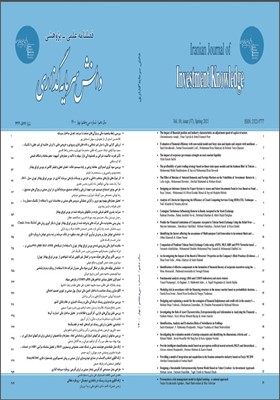استراتژی تحلیل بنیادی (شاخصهای RSS و CORFS) و بازدهی سهام
محورهای موضوعی : دانش سرمایهگذارییوسف پاشانژاد 1 , علی باغانی 2 * , سیده محبوبه جعفری 3 , علی نجفی مقدم 4 , زهره حاجیها 5
1 - دانشگاه آزاد تهران جنوب
2 - عضو هیات علمی، دانشکده اقتصاد و حسابداری، دانشگاه آزاد اسلامی، واحد تهران جنوب، تهران، ایران
3 - عضو هیئت علمی دانشگاه آزاد اسلامی واحد تهران جنوب
4 - مالی، مدیریت، دانشگاه آزاد تهران جنوب، تهران، ایران
5 - گروه آموزشی حسابداری، واحد تهران شرق، دانشگاه آزاد اسلامی، تهران، ایران
کلید واژه: شاخص RSS, بازدهی سهام, شاخص CORFS,
چکیده مقاله :
هدف از سرمایهگذاری در سهام، کسب بازده مناسب میباشد و عموماً تصمیمگیری سرمایهگذاران بر مبنای ریسک و بازده سهام و متأثر از دو عامل متغیرهای کلان اقتصادی و متغیرهای خرد اقتصادی میباشد. بهدلیل حساسیت زیاد سرمایهگذاران در کسب بیشترین بازده از سرمایهگذاریهای انجام شده و انتخاب بهترین پرتفوی سرمایهگذاری در بازارهای سرمایه، بخش قابل توجهی از پژوهشهای حوزه حسابداری و مالی، به بررسی وضعیت بازار سرمایه و پیشبینی بازده سهام اختصاص یافته است چراکه بررسی متغیرهای حسابداری اثرگذار بر بازده سهام میتواند در بررسی وضعیت آتی شرکت و بازده آتی سهام آن نیز مفید واقع شود. در مطالعه حاضر بررسی شد که آیا استراتژی تحلیل بنیادی مبتنی بر اطلاعات حسابداری میتواند به سرمایهگذاران کمک کند که عملکرد بهتری در پرتفوی سرمایهگذاریشان به ارمغان بیاورند یا خیر و در این راستا، از شاخصهای RSS و CORFS استفاده شد. جامعه آماری این تحقیق، شامل تمامی شرکتهای پذیرفته شده در بورس اوراق بهادار تهران از سال 1387 لغایت سال 1396 بوده و نمونه مورد بررسی، از طریق روش حذف سیستماتیک از جامعه آماری انتخاب شد. با توجه به شرایط معین، تعداد 118 شرکت بهعنوان نمونه آماری این تحقیق انتخاب شدند. گفتنی است با اجرای آزمونهای آنوا و طراحی مدلهای رگرسیونی چندمتغیره به آزمون فرضیههای تدوین شده پرداخته شد. نتایج بررسیها نشان داد که با تشکیل و محاسبه شاخص RSS نمیتوان به بازده بالاتری دست یافت؛ با تشکیل و محاسبه شاخص CORFS میتوان به بازده بالاتری دست یافت؛ و لذا شاخص CORFS نسبت به شاخص RSS، بازدهی بالاتری را به ارمغان میآورد.
The purpose of investing in stocks is to obtain appropriate returns and generally investors' decisions are based on risk and stock returns and are influenced by two factors: macroeconomic variables and microeconomic variables. Due to the high sensitivity of investors in obtaining the highest return on investment and selecting the best investment portfolio in the capital markets, a significant part of research in the field of accounting and finance, to examine the state of the capital market and before سهام The stock return is dedicated because the study of accounting variables affecting stock returns can be useful in assessing the future status of the company and its future stock returns. The present study examined whether an accounting-based fundamental analysis strategy can help investors perform better in their investment portfolio, using RSS and CORFS indicators. used. The statistical population of this study includes all companies listed on the Tehran Stock Exchange from 1387 to 1396 and the sample was selected through the method of systematic removal from the statistical population. According to the specific conditions, 118 companies were selected as a statistical sample of this study. It is worth mentioning that by performing ANOVA tests and designing multivariate regression models, the developed hypotheses were tested. The results showed that the formation and calculation of the RSS index can not achieve higher efficiency; By forming and calculating the CORFS index, higher efficiency can be achieved; Therefore, the CORFS index brings higher efficiency than the RSS index.
_||_

